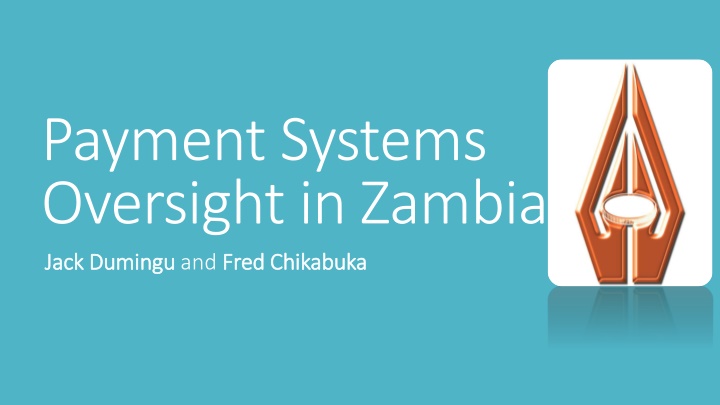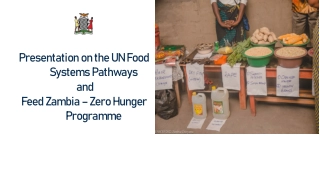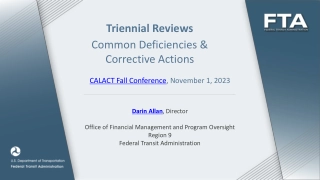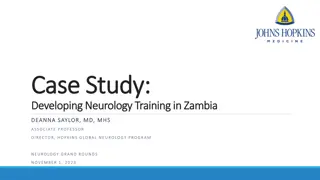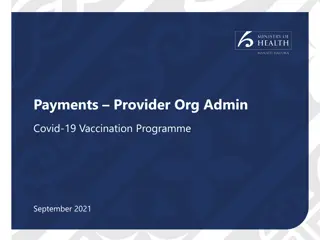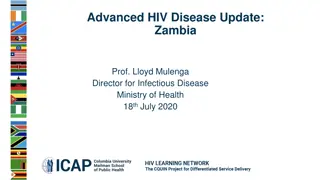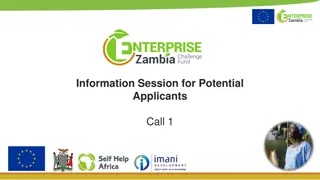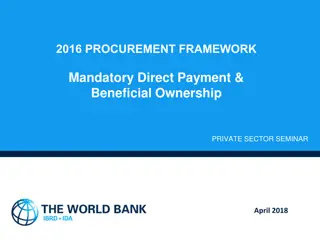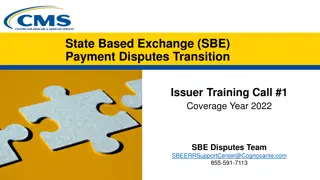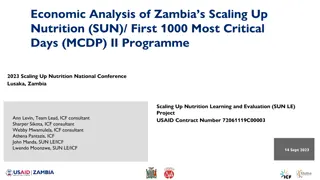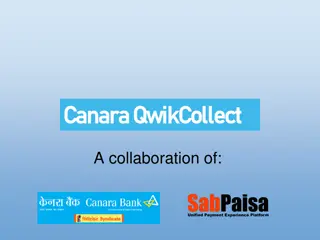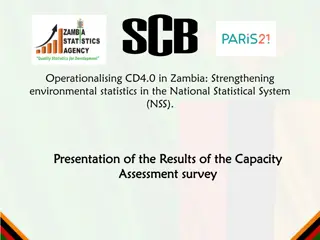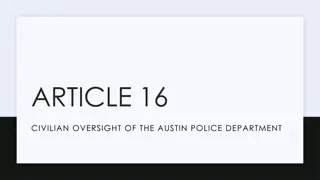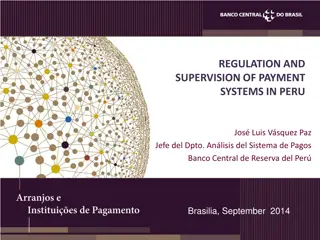Payment Systems Oversight in Zambia
Overview of payment systems in Zambia, including systemically important and non-systemically important systems, regional cross-border payments, ZIPSS volumes and values, and more. Learn about the institutional arrangements, legal framework, challenges, and lessons learnt in the payment ecosystem of Zambia.
Download Presentation

Please find below an Image/Link to download the presentation.
The content on the website is provided AS IS for your information and personal use only. It may not be sold, licensed, or shared on other websites without obtaining consent from the author.If you encounter any issues during the download, it is possible that the publisher has removed the file from their server.
You are allowed to download the files provided on this website for personal or commercial use, subject to the condition that they are used lawfully. All files are the property of their respective owners.
The content on the website is provided AS IS for your information and personal use only. It may not be sold, licensed, or shared on other websites without obtaining consent from the author.
E N D
Presentation Transcript
Payment Systems Oversight in Zambia Jack Dumingu Jack Dumingu and Fred Chikabuka Fred Chikabuka
Summary Summary 1. 1. Overview of Payment Systems in Zambia Overview of Payment Systems in Zambia 2. 2. Oversight Approach Oversight Approach 3. 3. Institutional Arrangements Institutional Arrangements 4. 4. Legal Framework Legal Framework 5. 5. Payment Systems Infrastructure Payment Systems Infrastructure 6. 6. Co Co- -operation with Other Regulatory Bodies operation with Other Regulatory Bodies 7. 7. Challenges Challenges 8. 8. Lessons Learnt Lessons Learnt
Overview Overview - -Payment Systems in Zambia Payment Systems in Zambia Payment Systems in Zambia are split into two categories Payment Systems in Zambia are split into two categories Systemically Important Payment Systems (SIPS) o These are system which had whose failure has the potential to trigger systemic risk and have an effect on the wider economy of the country. Systems included under this category are the - Zambia Interbank Payment and Settlement Systems (ZIPSS)/Real-time gross settlement (RTGS) - Electronic Funds Transfer (EFT)/Direct Debit and Credit Clearing (DDACC) system - Cheque Image Clearing (CIC) system
Overview Overview - -Payment Systems in Zambia Payment Systems in Zambia Non-Systemically Important Payment Systems (SIPS) o Non-systemically important payment system are additional payment systems in Zambia. Under this category of payment systems, the following are available; - Remittances (both domestic domesticand International International) - Automated Teller Machines (ATMs) - Point of Sale (PoS) - Mobile Payments
Overview Overview - -Payment Systems in Zambia Payment Systems in Zambia Regional Cross-border Payment ystems o Zambia belonging to both SADC and COMESA is participating in the SIRESS and the REPSS system Summary of performance some of these systems is shown in Summary of performance some of these systems is shown in following charts (at approximate exchange rate of K10.00/US$) following charts (at approximate exchange rate of K10.00/US$)
Overview Overview - -Payment Systems in Zambia Payment Systems in Zambia ZIPSS Volumes and Values ZIPSS Volumes and Values 100,000 500,000 Values (Approx. US$ million 80,000 400,000 equivalent) Volumes 60,000 300,000 40,000 200,000 20,000 100,000 - - 2010 2011 2012 2013 2014 2015 2016 2017 Values (Approx. USD$ equivalent) Volumes
Overview Overview - -Payment Systems in Zambia Payment Systems in Zambia EFT/DDACC Volumes and Values EFT/DDACC Volumes and Values 3,000 6,000,000.00 Values (Approx. US$ million 2,500 5,000,000.00 2,000 4,000,000.00 equivalent) 1,500 3,000,000.00 1,000 2,000,000.00 500 1,000,000.00 - - 2010 2011 2012 2013 2014 2015 2016 2017 Values (Approx. USD$ equivalent) Volumes
Overview Overview - -Payment Systems in Zambia Payment Systems in Zambia Cheque Processing Volumes and Values Cheque Processing Volumes and Values 100 500,000 Values (Approx. US$ million 80 400,000 equivalent) Volumes 60 300,000 40 200,000 20 100,000 - - 2010 2011 2012 2013 2014 2015 2016 2017 Values (Approx. USD$ equivalent) Volumes
Overview Overview - -Payment Systems in Zambia Payment Systems in Zambia Retail payment systems have recorded similar increases in Retail payment systems have recorded similar increases in values and volumes processed. values and volumes processed. Mobile payments have particularly increased substantially. Mobile payments have particularly increased substantially. Players in the payments systems include; Players in the payments systems include; 18 Commercial Banks 43+ payment system businesses offering various payment system (and mobile payment) services
Overview Overview - -Payment Systems in Zambia Payment Systems in Zambia Mobile Money Volumes and Values Mobile Money Volumes and Values 500 140,000,000.00 Values (Approx. US$ million 120,000,000.00 400 100,000,000.00 equivalent) 300 80,000,000.00 60,000,000.00 200 40,000,000.00 100 20,000,000.00 - - 2012 2013 2014 2015 2016 2017 Values (Approx. USD$ equivalent) Volumes
Oversight Approach Oversight Approach The Bank of Zambia takes a risk based oversight approach The Bank of Zambia takes a risk based oversight approach This entails carrying out more oversight on systems/institutions that are considered of higher risk Particular attention is given to the three systemically important system; ZIPSS, EFT/DDACC and Cheque clearing systems Bank of Zambia has currently drafting a risk based oversight manual which is undergoing internal review and approval On-site and off-site inspection are combined However Bank of Zambia also carries out regulation oversight However Bank of Zambia also carries out regulation oversight inspections (mostly on an annual basis) inspections (mostly on an annual basis)
Institutional Arrangement Institutional Arrangement Governor DG Operations DG - Administration Seniro Director Mon. Policy Senior Director Sup. Policy Director B,C&PS Assistant Director Payment Systems
Legal Framework Legal Framework The legal basis for Payment Systems is mainly on the following; The legal basis for Payment Systems is mainly on the following; Bank of Zambia Act o Bank of Zambia (BoZ) derives its functions and powers from the Bank of Zambia Act, no,43 of 1996. The Mission Statement of the Bank is to achieve and maintain price and financial system stability to foster sustainable economic development. Banking and Financial Services Act (BFSA) o Although the BFSA has no direct coverage over payment systems, due to related nature of the payment system and banking and financial services provision, the Payment System Division makes references to the BFSA
Legal Framework Legal Framework National Payment Systems Act (NPSA) of 2007 o Act empowers the Bank of Zambia to provide regulatory function that ensure safe, secure and reliable. o The purpose of the Act is to provide a legal backing for the operation of the various payment mechanism in Zambia. o The Bank of Zambia is in the process amending the Act - This is order to make enhancements in the Act - Harmonize it with other domestic regulations and the SADC Law - Incorporate learnings from other similar regulations
Legal Framework Legal Framework Other Supportive Regulations o These are issued/amended from time-to-time to address specific risk in the payment systems o Some of these include; - Directives on e-money issuance - BOZ AML Directives - Directives for Implementation of NFS - Various circulars
Legal Framework Legal Framework Payment System Rules o The NPSA requires that payment systems (which are licenced and designated by the Bank of Zambia) should put in place Rules, which should guide the operations of the payment system in question o Rules are in place for the ZIPSS/RTGS System and the EFT/DDACC and Cheque Clearing Systems o ATMs and PoS have depended on the VISA rules or respective card payment scheme. o Industry's is currently working on developing domestic rules for card and mobile payment.
Legal Framework Legal Framework Adoption of the Principles for Financial Markets Infrastructure Adoption of the Principles for Financial Markets Infrastructure The Bank of Zambia officially adopted the principles for financial markets infrastructure (PFMIs) issues by the BIS/CPMI in February, 2015 The Bank of Zambia required that all operators of Systemically Important Payment Systems and the two Central Securities Depositories (Bank of Zambia CSD and Lusaka Securities Exchange CSD) to conduct self assessment against PFMIs Staggered approach used where initial self-assessment was against only 6 principles and the remaining principles where done latter
Infrastructure Developments Infrastructure Developments Development of the National Financial Switch Development of the National Financial Switch The industry is working to develop the National Financial Switch (NFS) that will integrate and provide interoperability of various payment systems Phase 1 aims to commence domestic clearing and settlement for ATMs and PoS Phase 2 will commence domestic clearing and settlement for mobile payments
Infrastructure Developments Infrastructure Developments RTGS System Upgrade RTGS System Upgrade The Bank of Zambia upgraded the RTGS System in September, 2014. The new system provided a number of functionalities including the following; o Integration with IFMIS - this has allowed the Ministry of Finance to initiate payments from its IFMIS for settlement on the RTGS system o DvP the system is seamlessly integrated with the BOZ CSD system for securities trading o Integration with Revenue Authority sending of notifications for auto- receipting tax payments
Co Co- -operation with Other Regulators operation with Other Regulators The Bank of Zambia co The Bank of Zambia co- -operates with the following regulators operates with the following regulators The Zambia Information and Communications Technology Authority (ZICTA) who are a telco regulator. The Bank of Zambia and ZICTA have signed a Memorandum of Understanding (MOU) to provide for among other things conduct joint oversight and share key information and learning. The Securities and Exchange Commission (SEC), mainly is mainly in relation to the settlement aspect of securities trading The Pensions and Insurance Authority (PIA) The Financial Intelligence Centre (FIC) Country representation on the SADC PSOC
Challenges Challenges Man Power Man Power Payment System is not a fully fledged department, but is a division in the Banking, Currency and Payment Department However, the number of designated payment system businesses has continued to increase Increased Complexity of Modern Payment Systems Increased Complexity of Modern Payment Systems Payment systems have recently become more complex and technical, which is providing regulatory
Lessons Learnt Lessons Learnt Stakeholder Collaboration Key Stakeholder Collaboration Key Important to have collaborative effort in the conduct of oversight (as the appropriate skills and authroty all aspects) Adoption of Standard Adoption of Standard Standards adoption makes work easier as such standard are initially accepted But But It is important to harmonize such standards with the environment
Questions and Thanks Questions and Thanks
